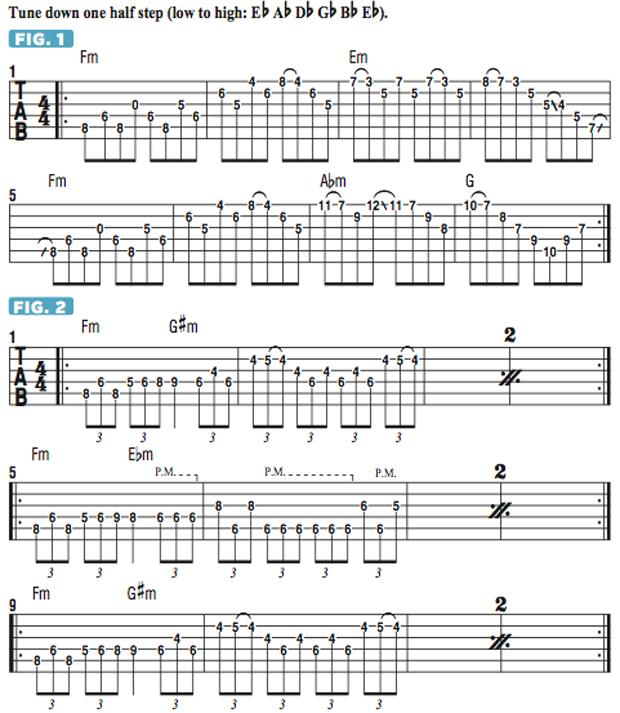Thrash Course with Dave Davidson: Moving Freely Throughout Different Tonal Centers

Last month, I discussed a few of the ways in which I like to utilize odd and mixed meters, as well as alternating between straight 4/4 time and odd meters, as compositional tools in writing music with Revocation.
Another technique I love to use is to take a particular melodic line, or “shape,” and re-imagine it in varying syncopated rhythms.
When you add to that a “free” harmonic approach, wherein reference to any fixed tonal center becomes ambiguous due to switching keys frequently within fast-moving figures, the possibilities for invention become endless.
These are some of the techniques I employed in crafting the primary riffs in “A Debt Owed to the Grave.”
The song opens with quick shifts between F minor and E minor triads, played in straight eighth notes in 4/4, although the rhythmic syncopation of the line is obscured by the unusual way in which the melody falls on the downbeats. During this intro, I’ll either begin or end a phrase in the middle of a bar or a beat to lend it a twisted feel.
At the first “chorus” section (1:00), I further develop the melodic content presented earlier by expanding to a series of minor arpeggios based on a progression of seemingly unrelated chords. As shown in FIGURE 1, the progression alluded to is two bars of Fm, two bars of Em, two bars of Fm, and then a bar of Abm followed by a bar of Gm. Shifting through minor keys half-steps apart like this lends an uncertain and unexpected quality to the music, which I find very appealing.
In FIGURE 1, the Fm arpeggio begins in sixth position and gradually moves back one fret at a time to fifth and then fourth positions. Notice the inclusion of the open G string in the line, which, in relation to Fm, serves as the major second.
Get The Pick Newsletter
All the latest guitar news, interviews, lessons, reviews, deals and more, direct to your inbox!
On beat three of bar 2, I pull off from the fifth of F, C, to the minor third, Ab, using my pinkie and index finger. At the beginning of bar 3, I play the same arpeggio shape one fret lower as a means to modulate down one half step to Em. I employ a similar technique in bars 7 and 8, as I move from Abm down to G major; the Abm is preceded by Fm and uses that same arpeggio shape shifted up three frets.
At the guitar solo (2:32), the feel of the tune switches to 12/8, which can also be interpreted as an eighth-note triplet feel in 4/4 time. This sets up the riff shown in FIGURE 2, for which I begin with a line rooted in Fm but modulate almost immediately to G#m, with the additional twist of starting the G#m-based melody on beat four of bar 1.
This two-bar figure is repeated three times, then the idea is permutated to set up a switch from Fm down one whole step to Ebm. Aside from the unusual harmonic progression, these fast-moving triplet lines can be challenging to articulate cleanly at tempo, so work through each phrase carefully and slowly before building up speed.
Hey, this is the last installment of Thrash Course for now, so I hope you’ve enjoyed the column, and I’ll see you out on the road!
Note: This month's edition of Thrash Course with Dave Davidson does not include a video! We're sorry for the inconvenience.

“I just learned them from the records. I don’t read tabs or anything, I don’t read music – I learned by ear”: How a teenage Muireann Bradley put a cover of Blind Blake’s Police Dog Blues on YouTube and became a standard bearer for country blues
“The Strat was about as ‘out’ as you could get. If you didn’t have a Floyd Rose, it was like, ‘what are you doing?’”: In the eye of the Superstrat hurricane, Yngwie Malmsteen stayed true to the original










